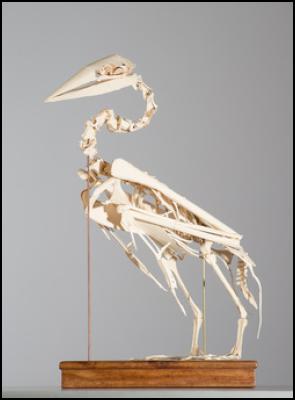Geoffrey Roche - The Morus Serrator Project
Geoffrey Roche - The Morus Serrator Project - 10th July to
4th August 2015
5/15/2015

The model for these drawings and maquettes is the skeleton of an Australasian Gannet (tākupu, Morus serrator), which was found at Otarawairere Beach, situated between Whakatāne and Ōhope, in the Bay of Plenty. The nearest gannet colony is on White Island. The skeleton’s legs and wings were broken, the caudal vertebrae and sclerotic eye rings were missing, and the limbs were tangled up in fishing line; it was too incomplete and damaged for mounting. A permit to retain the bodies of protected seabirds that have died of natural causes or have been accidentally killed was obtained from the Museum of New Zealand Te Papa Tongarewa, pursuant to the Wildlife Act 1953 section 55 (3).
The design and
construction process of the maquette has required extensive
study of both anatomy textbooks and mounted skeletons;
determining the correct sequence and orientation of the
vertebrae was particularly tricky. Once three- view drawings
of every bone were made to get a feel for dimensions and
forms, each was replicated in card. Construction of an
unarticulated prototype was followed by two further
articulated examples. All of the design and fabrication has
been done by hand.
The materials used to create the maquette are as follows: card (240gsm; about 20 sheets), entomological pins, florist’s wire (to reinforce the ribs), 18 gauge wire (to support the vertebrae), adhesive, and brass tubing, for support. There are 402 individual card parts, half of which make up the spine. Most of the vertebrae are as complex as the skull.
The design objectives, were, within the limits of the materials and methods, to evoke the presence of the living animal, and to at least point towards the complexity of the forms thrown up by Nature’s inscrutable Will.
The final stage of the
project will be the production of a book of plans and
assembly instructions, to allow for the construction of the
maquette by others, in the manner of the performance of a
piece of music.
Geoffrey Roche - Artist
information
Dr. Geoffrey Roche was born in 1973 in
Whakatane, in the Bay of Plenty, New Zealand. He received
his B.A. in Philosophy (with papers in physics and biology)
in 1996, his M.A. in Philosophy in 1998, and his PhD in
Philosophy in 2005; all at the University of Auckland. His
only training in illustration beyond 5th form high school
was in first year biology laboratory class, where dissection
drawings were a requirement.
Roche’s artistic practice explores themes first discussed in his MA thesis, The Motorcycle in the Art Gallery: Industrial Design and Art, being a critique of the contemporary Western dichotomy between technology and art (Roche 1997, amended 2008). In this text Roche notes the way in which engineers and inventors frequently operate in very artist- like ways, and have been inspired across history by naturally occurring forms, such as those of fish and birds.
Roche continues this line of inquiry through interpreting and modeling zoological anatomies in a rigorously methodological way, in an attempt to reverse- engineer them into forms that could be scaled or replicated, but also just to better understand them. The resulting assemblages are not so much artworks for their own sake as outputs of an ongoing investigation; works oftechné that stand outside the art/technology divide.
Morus serrator skull (2). Pencil drawing by
Geoffrey Roche
As such, Roche’s work implies a
fictional convergence between two technical practices that
flourished during the 19th Century: the teaching of zoology
through the creation of precision anatomical models
(particularly those of Dr. Louis Auzoux {1797-1880}), and
the scientific investigations into the flight of birds and
bats that contributed to the emergence of powered flight (by
OttoLilienthal{1848-1896}, Clément Ader {1841-1925}, and
Jean Marie Le Bris {1817-1872}). For these three
visionaries, the first step in achieving heavier- than-air
powered flight was to analyse the morphologies and flight
dynamics of birds and bats, and to construct and experiment
with bird- and bat- like flying machines designed in the
light of those studies. Now resembling the kinetic
sculptures of some long forgotten Surrealist, it was
partially through the creation of these machines, and the
wild imaginations of their builders, that the sky was
finally won.
Roche also writes on philosophical subjects, and has had book chapters and papers published in France, Japan, the United Kingdom, and the United States.He is currently researching the hallucinatory impact of ergot intoxication on the work of the early Renaissance painters Matthias Grünewald (c.1470/80-1528) and Hieronymus Bosch (c.1450-1516). Roche has lived in France, Japan, and the Republic of Korea, and currently lives in Wellington.
ends


 Prostate Cancer Foundation: Foundation Hails Select Committee Support For Prostate Screening Pilots
Prostate Cancer Foundation: Foundation Hails Select Committee Support For Prostate Screening Pilots Cross Street Music Festival: First Artists Announced For 2025 Cross Street Music Festival
Cross Street Music Festival: First Artists Announced For 2025 Cross Street Music Festival Bowls New Zealand: Lawson And Grantham Qualify To Keep Bowls Three-Peat Hopes Alive
Bowls New Zealand: Lawson And Grantham Qualify To Keep Bowls Three-Peat Hopes Alive Te Whatu Ora Health NZ: Health Warning – Unsafe Recreational Water Quality At South Bay And Peketā Beaches And Kahutara River Upstream Of SH1
Te Whatu Ora Health NZ: Health Warning – Unsafe Recreational Water Quality At South Bay And Peketā Beaches And Kahutara River Upstream Of SH1 Wikimedia Aotearoa NZ: Wikipedian At Large Sets Sights On Banks Peninsula
Wikimedia Aotearoa NZ: Wikipedian At Large Sets Sights On Banks Peninsula Water Safety New Zealand: Don’t Drink And Dive
Water Safety New Zealand: Don’t Drink And Dive